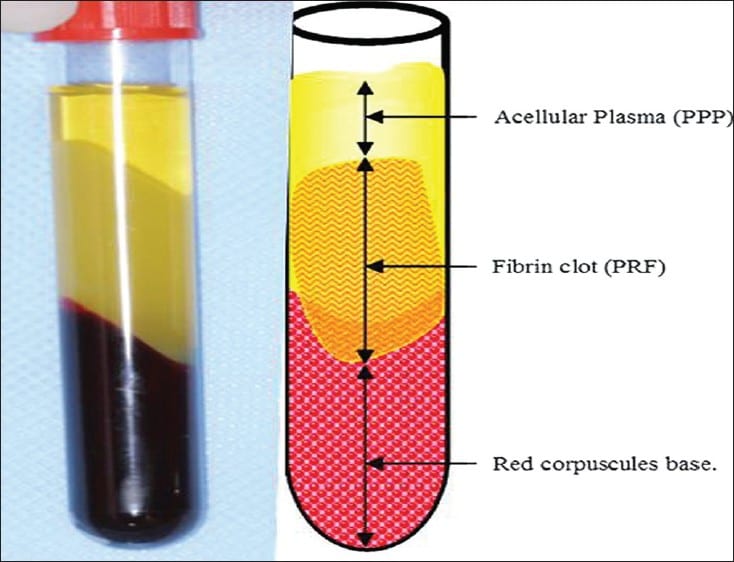PRF naturally improves bone healing after dental implants, wisdom teeth removal and bone grafting procedures. Dr Adams has been using platelet rich fibrin for over 10 years. PRF is not a stand alone procedure but it does improve the success of many of the surgical procedures we do. PRF also can reduce healing times and decrease post treatment pain and swelling. PRF can also reduce the risk of infection. PRF is short for platelet rich fibrin.

PRF dental platelet rich fibrin 1
What is Platelet Rich Fibrin?
Platelet Rich Fibrin or PRF is a yellow jello-like mixture of fibrin, platelets, white blood cells, stem cells and bone growth factors. The natural material is fabricated from the patients blood. Prior to a surgical procedure such as wisdom teeth removal, implant surgery or bone grafting, blood is drawn from the patients arm the same as is done for blood testing in a medical doctor’s office. The blood draw it typically done while the patient is getting numb for a procedure.
The platelet fibrin material is derived from spinning blood in a centrifuge at 2700 RPM for 13 minutes. The novel natural bone treatment is a great service for any biological dentist doing oral surgeon services with a natural and holistic approach. The holistic platelet treatment is a much better alternative to sending patients home with a naked bony extraction socket or implant site. In many cases, PRF treatment has been proven to be much more effective than gum and bone graft products purchased alone.

PRF extraction1
How is PRF used in Dental Surgery Procedures
- Tooth Extraction Sockets – platelet rich fibrin when placed into a tooth removal sites will reduce the risk of dry socket and infection after tooth removal. Most importantly, PRF treatment places the much needed immunological protection (white blood cells) and regenerative growth factors to promote proper healing in jaw bone. One serious problem in dentistry, is jaw bone infections that persist for day, months and sometimes years after oral surgery procedures.
- Dental Implants – PRF dental treatment when placed around implants during surgery accelerates implant healing and improves the quality of bone growth around implants. Platelet treatments appear to be help in titanium and zirconia dental implant surgery.
- Bone Graft Surgery – L-PRF can be processed and mixed with conventional bone graft products along with I-PRF to product a mixture called sticky bone. Sticky bone is an invaluable bone regeneration tool for any implant dentist or periodontist. Sticky bone can be especially helpful in getting severely infected root canal removal sites to heal properly. Sticky bone is also very helpful in building bone volume as in doing block bone grafts.
- PRF Membranes for grafting – when bone grafts products are placed into bony defects, the bone products can fall back out of the bony hole. Additionally gum tissue can grow into the area where the bone graft resides and prevent bone regeneration in the site. In these cases PRF membranes can be placed to prevent fall out of the graft and undesirable soft tissue growth.
How does PRF Work?
PRF is made by drawing a small amount of blood and spinning it in a centrifuge. There are no blood additives or chemicals. Only extracts from the patients blood drawn just before the surgical procedures. The most preparation of PRF is a yellow jello-like mixture of white blood cells, fibrin, platelets, stem cells and bone morphogenic proteins. The platelet treatment is used during many different oral surgery procedures.
PRF is used in tooth extractions sites to preserve bone
- occupy space in bony holes (tooth extraction sites, implant surgical sites) to prevent gum tissue from growing into bone
- prevents infection with a lot of white blood cells in PRF
- bone growth factors such as BMP (bone morphogenic protein) promote rapid growth of high quality new bone tissue.
In tooth extraction sites, PRF can be used as the only bone grafting material. PRF is often mixed with other off the shelf products such as cadaver bone, equine bone and bovine bone. There are so many different ways to used PRF in dentistry.
The Costs of PRF?
PRF therapies alone are not too expensive. Usually $300 – $700 which includes drawing blood, processing and placement into the surgical site. The actual cost of PRF depends on the application and how much is needed. Often PRF is just one ingredient of a treatment such as a block bone graft. Complex block bone grafts done by Dr. Adams usually have PRF mixed with cadaver bone. Stabilization of complex grafts requires a membrane. PRF can be flattened down and used as a membrane. The membrane helps contain the bone graft as it heals and creates a barrier between the bone and gum. Block bone graft techniques can cost between $1500 – $3500.

Meet Dr. Gary Adams
PRF preparations should be used in most dental surgical procedures…especially wisdom teeth removal…It accelerates and strengthens bone regeneration and lessens the chances of infection, pain and swelling.” Dr. Adams is a big supporter of PRF procedures for dental implants, bone grafting and oral maxillofacial surgery.
PRF Prevents Infection and Cavitations in Wisdom Teeth Extraction Sites
Oral surgery procedures come with a great risk of infection due to exposed bone tissue. Dry sockets are not uncommon. Especially in cases of tooth extractions and implants where bony defects (holes) extend open deep into the jaw. Care must be taken during any bone surgery. Wisdom teeth removal procedures come with the highest risk. Wisdom teeth are very difficult to clean and the jawbone is often already infected at the time of surgery. Platelet rich fibrin procedures are invaluable in getting proper healing after removal of wisdom teeth.
PRF Dental Implants Video
Advantages of Platelet Rich Fibrin Dental Treatments?
- Faster Implant Healing and Wisdom Tooth Removal Recovery
- Reduced Inflammation and Pain after Oral Surgery Procedures
- PRF promotes less swelling before and after implant surgery
- Improved quality of bone osseointegration around implants
- Increased bone grafting success
- PRF reduces dry socket and bone pathology after wisdom teeth extractions
- increased early blood supply into extraction sockets
- improves success in difficult surgical sites such as root canal removal sites and full mouth dental implants such as all on four implants.
- PRF is the best sinus lift grafting material
How does PRP and PRF Work in Dentistry?
Jaw bone is exposed and cleaned during surgery. Bone has very little blood supply compared to other tissues in the body. Tissue where there is less blood, the body has reduced ability to heal properly and less defense against bacterial and fungal infection. We place platelet concentrated treatments into tooth extraction sites and implanted teeth sites. Without prf, extraction sites are commonly left to heal naked and open to the oral cavity. During extraction site healing, saliva, bacteria and other contaminants pour down into vulnerable jaw bone. When platelet and fibrin rich therapies are placed into extraction sockets, the treatment protects the site from infection and enriches the area with proteins and growth factors that promote new bone growth. In sites where implants are placed, PRF occupies the space between the bony socket and the dental implant. Dental implant sites with fibrin-platelet therapy have increased surgical success rates and decreases bacterial infection rates in bone.
I-PRF VS L-PRF – What is the difference?
I-PRF is termed “injectable prf”. It is processed by spinning the patient blood for a shorter amount of time at a slower speed in the centrifuge. The L-PRF is thicker in consistency like jello. The injectable is more runny like syrup or thick juice. The injectable platelet product, is richer in growth factors and has not yet fully clotted. It can be injected since it is thin in consistency. The most common use for I-PRF in dentistry is mixing it with L-PRF and bone graft products to produce a substance called sticky bone. L-PRF and conventional bone graph products is a loose granular mixture and difficult to work with during surgery. When I-PRF is used to wet the granular mixture, the I-PRF clots after a few minutes and causes the entire mixture to become sticky and clump tightly together. The “clumping” of the bone graft preparation is very helpful clinically when an implant dentist is trying to get a bone graft to stay in a surgical site.
Sticky Bone Video with I-PRF, L-PRF and Bone Graft Material
How to Make Platelet-Fibrin Treatments
If you know how to draw blood, processing PRF dental treatment is very simple. In most instances, we draw one vial of blood per site. Taking blood is exactly the same as when blood is taken during a medical physical. Platelet Rich Fibrin treatment is 100% natural and we do not use any additives or preservatives. The blood is drawn immediately prior to the procedure normally while the patient is getting numb for the surgery. The blood is then put into a centrifuge at 2700 RPM for 13 minutes. 13 minutes later, blood is separated into 3 layers:
- plasma layer – PRP of platelet rich plasma
- red layer
- yellow layer rich in PRF
What is the difference between PRP and PRF in Dentistry?
PRP is the red part of the blood spin containing the red blood cells. PRP is not useful in dental bone surgery. PRP is very useful in injecting into painful joints and other soft tissue areas but not in dentistry.
Schedule Consultation


 (301) 421 1996
(301) 421 1996 burtonsvillesmiles@gmail.com
burtonsvillesmiles@gmail.com